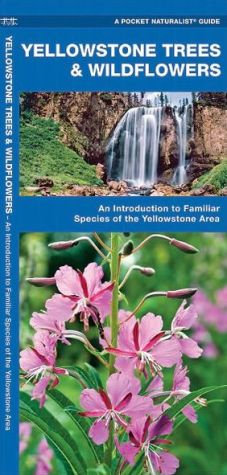

 |

|

The average rating for Yellowstone Trees and Wildflowers: An Introduction to Familiar Species of the Yellowstone Area based on 2 reviews is 4 stars.
Review # 1 was written on 2016-01-02 00:00:00 Danielle Aubuchon Danielle AubuchonFinished reading Walter Taylor's The Guide to Florida Wildflowers. This hardback book is richly illustrated with great information on plant identification and full color pictures of the flowers - 2 to a page - over 800 plants. Walter goes into depth at the beginning of the book on terminology and identification points. Never realized there was terminology for different leaf shapes. Just the beginning makes the book worthwhile. Also includes commentary on each plant - some very interesting such as medicinal uses or carnivorous. The book is arranged according to the color of the flowers with white, yellow, green, lavender, purple and red sections. I first heard of this book earlier this year while watching an episode of Wildlife Matters, a production of Orange County's Vision TV channel. The episode was on wildflowers and included an interview with Walter in the Tosohatchee Preserve and a discussion of his books. I've spent a good bit of time there this year hiking and fishing and enjoying the wildlife. I thought a color-coded book would be a good way to start identifying wildflowers. It wasn't easy to find, and it's not cheap. Went on a flower trek in the Toso with the Florida Native Plant Society a couple months ago. These people are SERIOUS about their plants and spout Latin names. As a novice I was completely out-classed. I had Walter's book with me and more than one said it's a good BEGINNER'S guide. I was crestfallen thinking I had bought a child's book. But as the tour progressed, they got into disagreements on plant identification, and repeatedly grabbed my book away to settle their arguments. I felt vindicated. Overall, I would highly recommend this book for anyone interested in getting to know Florida Wildflowers. I do have some criticisms, however: 1) Did I mention this book is color-coded? A lot of flowers to not fit neatly into a specific color category. They are multi-colored or they change colors as they age. 2) One of us is color-blind. Several plants seemed miscategorized to me. Walter has Batchelor Buttons in the red section, and they are flagrantly yellow, including the picture used in his illustration. 3) For the life of me I could not figure out how he had arranged the plants within each color section. Not by common name, not by Latin name, not by terrain where they grow or the time they bloom. A mystery without any clues. 4) Did I mention it's a hardback? VERY hardback, which means if you're traipsing around in the woods you can't roll it up and put it in a pocket. Also not easy to put on a bicycle. 5) It's difficult to find. I got mine at Barnes and Noble in Colonial Promenade. I was in a hurry or I would have ordered online, because it's also… 6) Expensive. Paid $30 for my copy. Still, I recommend it. Next time I'm weeding I'm taking it out in the yard with me. Would like to know what I'm pulling up. |
Review # 2 was written on 2015-08-08 00:00:00 Leo Calica Leo CalicaI enjoyed this book on wildflowers. The pros: the pictures, for the most part, are nice. I was able to identify numerous plants that I've seen locally. The information is good but basic: latin name, description of flowers, where it is found, habitat and flowering time. Of course, nothing is written in stone. It may say you can grow it in the north but you may find it in Leesburg, FL (central region). The cons: I would like to have known if the plant was invasive. If not; how do you propagate it. Also, whether the plant was in danger. I would like to have known if it is good to grow for butterflies/birds or is a food source for beneficial insects. Perhaps some kind of simple key could have been used with each description? Japanese honeysuckle is a good plant that needs more information to to lay individuals. I found out there are 52 species of Lonicera and the one shown in the book is invasive in numerous states including FL. Yet I've seen it for sale in nurseries and on websites. Lantana is another plant people need to be leery of. On the USDA website it is listed as a native plant in FL (L. depressa) and is now considered endangered but the book does not include it. The problem is the native Florida lantana is often confused with the invasive species. Lantana is found in almost every county in Florida. I had an instance where a bird must have dropped some seed and the plant took over a certain area in my yard. It was very hard to pull up and, though I was careful to get the whole plant, I must have dropped some seed and it started again next year. It took several seasons to get rid of it. And people grow it intentionally.... My ideal book on Florida wildflowers would be one that has great clear, concise and colorful pictures, good basic information and the additional symbols (key) as listed above. I realize that an author can't include everything but maybe another symbol (key) that could tell the reader to get more information if they are considering growing it. I know that some of the "wildflowers" are weeds to me and I wouldn't dream of growing it or giving the plant away. Comment | Permalink |
CAN'T FIND WHAT YOU'RE LOOKING FOR? CLICK HERE!!!